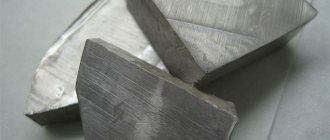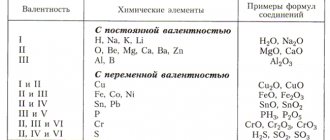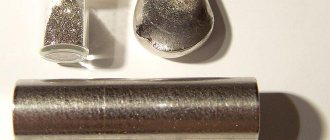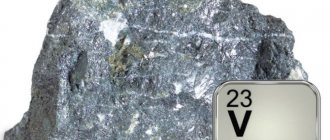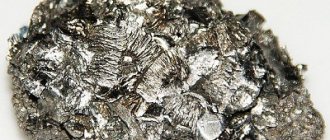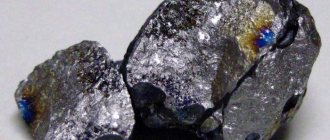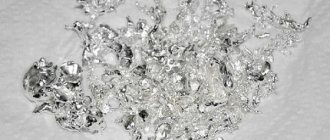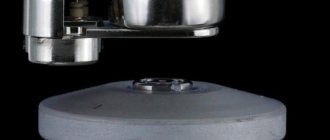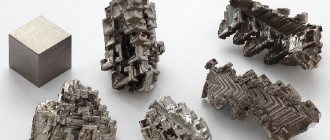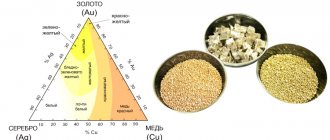If a fiction writer had to deal with the “biography” of cesium, he might begin like this: “Cesium was discovered relatively recently, in 1860, in the mineral waters of famous healing springs in the Black Forest (Baden-Baden, etc.). In a short historical period, a brilliant path has passed - from a rare, unknown chemical element to a strategic metal. He belongs to the working family of alkali metals, but the blue blood of the last of his kind flows in his veins... However, this does not in the least prevent him from communicating with other elements, and even if they are not so famous, he willingly comes into contact with them and establishes strong connections.
Cesium
Currently, he works simultaneously in several industries: in electronics and automation, in radar and cinema, in nuclear reactors and on spaceships...” Without taking seriously the humorous tone and some clearly literary exaggerations, this biography can easily be taken as a “novel without lies.” The conversation about the “blue blood” of cesium is not pointless - it was first discovered by two bright lines in the blue region of the spectrum and the Latin word “caesius”, from which its name comes, means sky blue. It is undeniable that cesium is practically the last in the series of alkali metals. True, Mendeleev prudently left in his table an empty cell for “ecacesium,” which was supposed to follow cesium in group I. And this element (Francium) was discovered in 1939. However, francium exists only in the form of rapidly decaying radioactive isotopes with half-lives of a few minutes, seconds or even thousandths of a second. Finally, it is also true that cesium is used in some of the most important areas of modern technology and science.
General information:
| 100 | General information | |
| 101 | Name | Cesium |
| 102 | Former name | |
| 103 | Latin name | Caesium |
| 104 | English name | Caesium, Cesium (in USA) |
| 105 | Symbol | Cs |
| 106 | Atomic number (number in table) | 55 |
| 107 | Type | Metal |
| 108 | Group | Alkali metal |
| 109 | Open | Robert Wilhelm Bunsen and Gustav Robert Kirchhoff, Germany , 1860 |
| 110 | Opening year | 1860 |
| 111 | Appearance, etc. | Very soft, tough silver-yellow metal |
| 112 | Origin | Natural material |
| 113 | Modifications | |
| 114 | Allotropic modifications | |
| 115 | Temperature and other conditions for the transition of allotropic modifications into each other | |
| 116 | Bose-Einstein condensate | 33Cs |
| 117 | 2D materials | |
| 118 | Content in the atmosphere and air (by mass) | 0 % |
| 119 | Content in the earth's crust (by mass) | 0,00019 % |
| 120 | Content in seas and oceans (by mass) | 5,0·10-8 % |
| 121 | Content in the Universe and space (by mass) | 8,0·10-8 % |
| 122 | Abundance in the Sun (by mass) | 8,0·10-7 % |
| 123 | Content in meteorites (by mass) | 0,000014 % |
| 124 | Content in the human body (by weight) | 2,0·10-6 % |
Historical background
The credit for the discovery of the electronic formula of cesium belongs to chemists from Germany, outstanding minds in their field, Kirchhoff and Bunsen. This event happened back in 1860. During that period, they began to actively change the newly invented flame spectroscopy technique, and in the course of their experiments, German scientists discovered a chemical element previously unknown to the public - cesium. At that moment, cesium was presented as a recipient, which is relevant for photocells and electron tubes.
Noticeable changes in the history of the definition and isolation of the element occurred in 1967. Taking into account Einstein's statement that the speed of light can be considered the most constant measuring factor inherent in our universe, it was decided to isolate cesium 133. This became an important point in expanding the range of applications of the chemical element cesium - in particular, it is used to make atomic clocks.
Properties of the cesium atom:
| 200 | Properties of the atom | |
| 201 | Atomic mass ( molar mass ) | 132.9054519(2) amu (g/mol) |
| 202 | Electronic configuration | 1s2 2s2 2p6 3s2 3p6 3d10 4s2 4p6 4d10 5s2 5p6 6s1 |
| 203 | Electronic shell | K2 L8 M18 N18 O8 P1 Q0 R0 |
| 204 | Atomic radius (calculated) | 298 pm |
| 205 | Empirical atomic radius | 265 pm |
| 206 | Covalent radius* | 244 pm |
| 207 | Ion radius (crystalline) | Cs+ 181 (6) pm, 188 (8) pm, 195 (10) pm, 202 (12) pm (in parentheses the coordination number is indicated - a characteristic that determines the number of nearest particles (ions or atoms) in a molecule or crystal) |
| 208 | Van der Waals radius | 343 pm |
| 209 | Electrons, Protons, Neutrons | 55 electrons, 55 protons, 78 neutrons |
| 210 | Family (block) | s-family element |
| 211 | Period in the periodic table | 6 |
| 212 | Group on the periodic table | 1st group (according to the old classification - the main subgroup of the 1st group) |
| 213 | Emission spectrum |
Compatibility and features
Cesium has the ability to react with alkaline compounds and metals. The element also forms cesium oxides. In addition, reactions with mercury mixtures and gold are observed. Features of interaction with other compounds, as well as temperature conditions at which reactions are possible, indicate possible intermetallic compositions. In particular, cesium is the starting component for the formation of photosensitive compounds. To do this, a metal reaction is carried out with the participation of thorium, antimony, gallium, and indium.
In addition to cesium oxide, chemists are also interested in the results of interaction with a number of alkaline elements. At the same time, it must be taken into account that the metal cannot react with lithium. Each of the cesium alloys has its own shade. Some mixtures are black-violet compounds, others have a golden hue, and others are almost colorless but have a distinct metallic sheen.
Chemical properties of cesium:
| 300 | Chemical properties | |
| 301 | Oxidation states | -1, +1 |
| 302 | Valence | I |
| 303 | Electronegativity | 0.79 (Pauling scale) |
| 304 | Ionization energy (first electron) | 375.7 kJ/mol (3.893905695(24) eV) |
| 305 | Electrode potential | Cs+ + e— → Cs, Eo = -2.923 V |
| 306 | Electron affinity energy of an atom | 45.505(3) kJ/mol (0.471630(25) eV) |
Work continues
It is no secret that discovering an element and obtaining it in its pure form are two completely different tasks, although they are interconnected. When it became clear that cesium was very rare, scientists began to develop techniques for synthesizing the metal in the laboratory. At first it seemed that this was a completely impossible task if we used the means and technology available at that time. Over the years, Bunsen was unable to isolate cesium metal in its pure form. It was only two decades later that advanced chemists were finally able to solve this problem.
The breakthrough occurred in 1882, when Setterberg from Sweden electrolyzed a mixture consisting of four parts cesium cyanide, to which one part barium was mixed. The latter component was used to make the melting point lower. Cyanide, as scientists already knew at this point, was a very dangerous component. At the same time, contamination was formed due to barium, which did not make it possible to obtain a more or less satisfactory amount of cesium. It was clear that the technique required significant improvements. A good proposal in this area was submitted for discussion to the scientific community by Beketov. It was then that cesium hydroxide attracted attention. If this compound is restored by using metallic magnesium, increasing the heat and using a hydrogen current, a slightly better result can be achieved than that proven by the Swedish chemist. However, real experiments have shown that the yield is half that calculated in theory.
Physical properties of cesium:
| 400 | Physical properties | |
| 401 | Density* | 1.93 g/cm3 (at 20 °C and other standard conditions, state of matter – solid), 1.887 g/cm3 (at a melting point of 28.5°C and other standard conditions, state of matter – solid), 1.843 g/cm3 (at a melting point of 28.5 °C and other standard conditions , the state of the substance is liquid), 1.78 g/cm3 (at 127 °C and other standard conditions, state of matter – liquid), 1.552 g/cm3 (at 527 °C and other standard conditions, state of matter – liquid) |
| 402 | Melting temperature | 28.5 °C (301.7 K, 83.3 °F) |
| 403 | Boiling temperature* | 671 °C (944 K, 1240 °F) |
| 404 | Sublimation temperature | |
| 405 | Decomposition temperature | |
| 406 | Self-ignition temperature of a gas-air mixture | |
| 407 | Specific heat of fusion (enthalpy of fusion ΔHpl) | 2.09 kJ/mol |
| 408 | Specific heat of evaporation (enthalpy of boiling ΔHboiling)* | 63.9 kJ/mol |
| 409 | Specific heat capacity at constant pressure | |
| 410 | Molar heat capacity | 32.21 J/(K mol) |
| 411 | Molar volume | 70.732 cm³/mol |
| 412 | Thermal conductivity | 35.9 W/(mK) (at standard conditions), 35.9 W/(mK) (at 300 K) |
| 413 | Thermal expansion coefficient | |
| 414 | Thermal diffusivity coefficient | |
| 415 | Critical temperature* | |
| 416 | Critical pressure | |
| 417 | Critical Density | |
| 418 | Triple point | |
| 419 | Vapor pressure (mmHg) | |
| 420 | Vapor pressure (Pa) | |
| 421 | Standard enthalpy of formation ΔH | |
| 422 | Standard Gibbs energy of formation ΔG | |
| 423 | Standard entropy of matter S | |
| 424 | Standard molar heat capacity Cp | |
| 425 | Enthalpy of dissociation ΔHdiss | |
| 426 | The dielectric constant | |
| 427 | Magnetic type | |
| 428 | Curie point | |
| 429 | Volume magnetic susceptibility | |
| 430 | Specific magnetic susceptibility | |
| 431 | Molar magnetic susceptibility | |
| 432 | Electric type | |
| 433 | Electrical conductivity in the solid phase | |
| 434 | Electrical resistivity | |
| 435 | Superconductivity at temperature | |
| 436 | Critical magnetic field of superconductivity destruction | |
| 437 | Prohibited area | |
| 438 | Charge carrier concentration | |
| 439 | Mohs hardness | |
| 440 | Brinell hardness | |
| 441 | Vickers hardness | |
| 442 | Sound speed | |
| 443 | Surface tension | |
| 444 | Dynamic viscosity of gases and liquids | |
| 445 | Explosive concentrations of gas-air mixture, % volume | |
| 446 | Explosive concentrations of a mixture of gas and oxygen, % volume | |
| 446 | Ultimate tensile strength | |
| 447 | Yield strength | |
| 448 | Elongation limit | |
| 449 | Young's modulus | |
| 450 | Shear modulus | |
| 451 | Bulk modulus of elasticity | |
| 452 | Poisson's ratio | |
| 453 | Refractive index |
So similar, but completely different
When comparing the distinctive features of cesium and rubidium, as well as other elements that are extremely rare, it was possible to reveal that cesium is characterized by the formation of unique minerals, which other compounds are not capable of. This is how pollucite, rodicite, and avogadrite are obtained.
Rodicite, as scientists have found, is extremely rare. Likewise, avogadrite is very difficult to find. Pollucite is somewhat more common, with small deposits found in a number of cases. They have very low power, but contain cesium in an amount of 20-35 percent of the total mass. The most important, from the public's point of view, pollucites were discovered in the American subsoil and in Russia. There are also Swedish and Kazakh developments. It is known that pollucite was found in the southwest of the African continent.
Cesium crystal lattice:
| 500 | Crystal cell | |
| 511 | Crystal grid #1 | |
| 512 | Lattice structure | Cubic body-centered |
| 513 | Lattice parameters | 6.140 Å |
| 514 | c/a ratio | |
| 515 | Debye temperature | 39.2 K |
| 516 | Name of space symmetry group | Im_ 3m |
| 517 | Symmetry space group number | 229 |
Activity and reactions
In the course of numerous studies, scientists were able to determine that cesium has an amazing activity that is not normally characteristic of metals. Upon contact with air, combustion occurs, which leads to the release of superoxide. Oxide can be achieved by limiting the access of oxygen to the reagents. There is a possibility of formation of suboxides.
If cesium comes into contact with phosphorus, sulfur, or halogen, this provokes an explosive reaction. The explosion is also accompanied by a reaction with water. Using a crystallizer or glass, you may encounter the container literally falling into pieces. A reaction with ice is also possible if the temperature on the Celsius scale is not lower than 116 degrees. As a result of this reaction, hydrogen and hydroxide are produced.
Bismuth
It usually looks like this:
nexmetal.com
But under the right conditions it might look like this:
Wikipedia
We recommend using an image search on Yandex or Google for “Bismuth crystals” to see all the miracles that bismuth can produce.
Some other interesting facts about bismuth:
- Bismuth (bismuth-209, the most common isotope) is radioactive but has one of the longest half-lives ever measured. Its half-life is 1.9x10^19 years, or about a billion times longer than the existence of the Universe.
- Bismuth is the strongest naturally occurring diamagnetic metal known. Diamagnetic materials, when exposed to a magnetic field, create a repulsive field in response. So, with some strong magnets you can make bismuth rise.
- Bismuth has unusually low toxicity to heavy metals. Its neighbors on the periodic chart - polonium, antimony and lead - are quite toxic, but bismuth is relatively harmless. Because of this, bismuth is being explored as an alternative to lead for some applications.
- Most people use bismuth in their lives. The active ingredient in Pepto-Bismol is bismuth subsalicylate.
Application
In 1962, the US began supplying the irritant CS to South Vietnam. After 2 years, this compound was used in the fight against the partisan movement during the civil war. From that moment on, it began to be widely used by American troops. According to some reports, the total amount of chlorobenzalmalonodinitrile consumed during the Vietnam War was more than 6,000 tons.
After its successful use for military purposes, it began to be used by the police to restore public order. However, when its teratogenic properties were discovered, it was withdrawn from service in European countries. According to the 1993 Chemical Weapons Convention, this compound is prohibited from being used for military purposes, but in a number of countries (Bahrain, Nepal, South Korea, Egypt) it is still in use.
There are safer irritants that are similar in action to the CS substance. Pelargonic acid morpholide in the form of an aerosol also irritates the organs of vision and breathing, but these symptoms pass faster (within 10-15 minutes in the fresh air) and do not require treatment. This chemical is much less toxic.
History of creation
The substance CS was first obtained in 1928 at Middlebury College in Vermont (England). It was synthesized by two American chemists B. Corson and R. Stone. They systematically studied the reactions of aldehydes and ketones with malonic acid dinitrile. As a result, several new compounds were obtained, among which was chlorobenzalmalonodinitrile. The name of the substance CS comes from the first letters of the names of its discoverers (Corson and Stoughton). Even then its psychophysiological properties were noticed. In their 13-page report, scientists recorded that it causes severe tearing and sneezing.
The connection did not attract much attention at the time. However, at the end of the 50s. XX century Specialists from the British Ministry of Defense, who at that time were actively engaged in the search for effective chemical weapons, became interested in it. Soon it was tested in practice, first on animals, then on volunteers of the English army, and after that during military operations in some countries. Its industrial synthesis was established at the chemical plant in Nanskyuk, and in 1954 the CS toxic substance was adopted by the police and the US National Guard.
Isotopes
Main article: Cesium isotopes
Cesium isotopes are known with mass numbers from 112 to 151 (number of protons 55, neutrons from 57 to 96), and 22 nuclear isomers. Natural cesium is a monoisotopic element consisting of a single stable isotope, 133Cs.
Decay scheme of Cs-137
The longest-lived artificial radioactive cesium nuclide is 135Cs with a half-life T
1/2 about 2.3 million years.
Another relatively long-lived isotope is 137Cs ( T
1/2 = 30.17 years).
Cesium-137 is one of the culprits of radioactive contamination of the biosphere, as it is formed during nuclear fission in nuclear reactors and during nuclear weapons testing. Cesium-137 undergoes beta decay, the daughter isotope is stable barium-137.
Use wisely
Not only cesium, but also compounds known based on this metal are currently used very widely. Without them it is impossible to imagine the design of radio engineering; they are also indispensable in electronics. Cesium compounds and variations are actively used in chemistry, industry, ophthalmology, and medicine. Cesium has not been ignored in the development of technologies applicable in space, as well as nuclear energy.
It is now common to use cesium in the construction of solar cells. Bromide and iodide of this metal are necessary to create infrared vision systems. Industrially produced single crystals can be used as detector elements that allow recording ionizing radiation. Some cesium-based compounds are actively used as catalysts in industrial processes. This is necessary in the creation of ammonia, the formation of ethylene oxide and the production of butadiene.
Effect on the human body
Chlorobenzalmalonodinitrile in the form of an aerosol can cause the following negative effects:
- severe lacrimation;
- burning sensation in the nasopharynx;
- chest pain;
- conjunctivitis;
- dryness, skin irritation;
- nose bleed.
Although CS is not considered lethal, it can cause damage to the lungs, liver and heart at concentrations of 0.27 mg/L and above, especially in confined spaces and with prolonged exposure. Animal experiments have also shown that it has a teratogenic effect. The dangerous concentration in the air is 0.002 mg/l. The toxic effect is detected within a few seconds and disappears in 15-30 minutes. Redness of the skin may persist for several hours.
Receipt
In industrial production, cesium in the form of compounds is extracted from the mineral pollucite. This is done by chloride or sulfate opening. The first involves treating the original mineral with heated hydrochloric acid, adding antimony chloride SbCl3 to precipitate the compound Cs3[Sb2Cl9] and washing with hot water or ammonia solution to form cesium chloride CsCl. In the second case, the mineral is treated with heated sulfuric acid to form cesium alum CsAl(SO4)2·12H2O.
To obtain cesium of a sufficient degree of purity, repeated rectification in a vacuum, purification from mechanical impurities on metal-ceramic filters, heating with getters to remove traces of hydrogen, nitrogen, oxygen and repeated stepwise crystallization are required.
The difficulties of obtaining cesium determine the constant search for its minerals: the extraction of this metal from ores is incomplete, during the operation of the material it dissipates and is therefore irretrievably lost. Industry needs very pure material (at the level of 99.9-99.999%), and this is one of the the most difficult problems in the metallurgy of rare elements.
In Russia, the processing and extraction of cesium salts from pollucite is carried out in Novosibirsk at ZAO Rare Metals Plant.
There are several laboratory methods for obtaining cesium. It can be obtained:
- heating in vacuum a mixture of cesium chromate or dichromate with zirconium;
- decomposition of cesium azide in vacuum;
- heating a mixture of cesium chloride and specially prepared calcium.
All methods are labor intensive. The second allows you to obtain high-purity metal, but is explosive and requires several days to implement.
Forms
To obtain an aerosol of chlorobenzalmalonodinitrile, several methods are used:
- dissolution in organic solvents;
- melting and spraying into liquid form;
- use of siliconized powder (to prevent clumping of the active substance);
- introduction of explosive ammunition (artillery shells, chemical bombs, aviation cassettes, hand grenades), pyrotechnic mixtures;
- application in mechanical aerosol generators and dispersants.
Hydroxide: features
While studying the reaction products produced by cesium, chemists discovered that the resulting hydroxide is a very strong base. When interacting with it, you must remember that at high concentrations this compound can easily destroy glass even without additional heating. But when the temperature rises, the hydroxide easily melts nickel, iron, and cobalt. The effect on zirconium dioxide, corundum, and platinum will be similar. If oxygen takes part in the reaction, cesium hydroxide extremely quickly destroys silver and gold. If you limit the supply of oxygen, the process proceeds relatively slowly, but still does not stop. Rhodium and several alloys of this compound are resistant to cesium hydroxide.
France
Francium is VERY reactive and has atomic number 87.
Francium is a very reactive and radioactive element. Because it has a half-life of 22 minutes, it is highly reactive.
In fact, this has never been tested due to the risks it poses. However, scientists have made a replica of what it would be like if you dropped it in water.
Look what this would lead to:
Here are some photos of francium being tested on (but only with small amounts)
Finally, this is what francium looks like.
